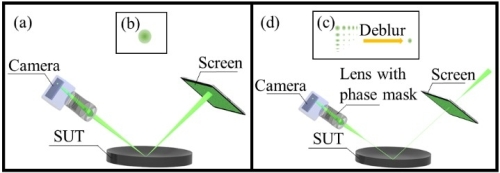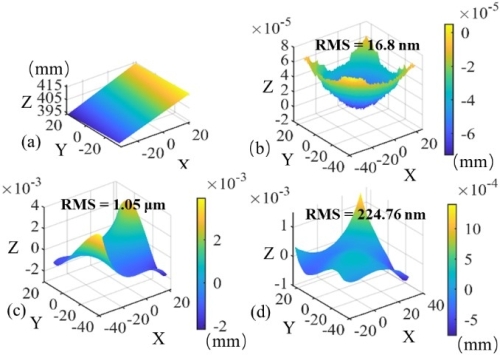Researchers from Precision Optical Manufacturing and Testing Center of Shanghai Institute of Optics and Fine Mechanics (SIOM) of Chinese Academy of Sciences (CAS) propose the wavefront-encoded deflectometry for the first time in the research, which significantly improves the measuring depth of field (DoF), eliminates the position-angle uncertainty of the deflectometry, and realizes high-precision surface measurement without precise focusing conditions. The research results greatly improve the flexibility and accuracy of deflectometry, expand the ability of deflectometry to measure large-aperture components under the long measuring optic path, and lay a foundation for the development of intelligent optical manufacturing in the future. Relevant achievements were published in Optics Letters on September 12, 2022.
Large-aperture complex curved optical elements are widely used in astronomical telescopes, X-ray scientific devices, high-energy laser systems and other fields. They have the advantages of improving image quality, improving optical performance and expanding the field of view. They are the frontier hot research direction of precision optics. Deflectometry has the advantages of high precision, large dynamic measurement range and strong anti-interference ability. It has great potential to achieve high-precision measurement of complex optical surfaces.
Due to the limitation of measuring DoF, it is impossible to focus on the screen and the measured surface at the same time, causing the troubles to obtain the surface position (depending on the size of the surface detection unit) and normal vector (depending on the angle measurement accuracy of the incident light) with high accuracy at the same time. Therefore, there is a problem of position-angle uncertainty. The characteristics of such components, such as large aperture and complex surface shape, require that the measuring optical path is too long, which aggravates the position-angle uncertainty issue, and seriously affects the accuracy of surface measurement and the flexibility and stability of the measurement system.
To solve this problem, this research proposes a wavefront-encoding deflectometry, which shapes the system wavefront by optimizing the cubic phase plate. The phase plate presents a consistent response in the extended DoF, and then adaptive fuzzy kernel estimation and deconvolution algorithm for accurate wavefront are applied to decode the wavefront to achieve high-precision measurement results without precise focusing conditions. Compared with traditional deflectometry, the measuring DoF by the proposed wavefront-encoding deflectometry is significantly improved, and the screen and the measured surface can be simultaneously in focus, as shown in Figure 1.
In this study, a cubic phase plate is used to modulate the wavefront phase to generate a highly consistent PSF in the extended DoF. Figure 2 shows that the PSF of the traditional deflectometry at the measured surface and screen is quite different, and the PSF of the proposed wavefront-encoding deflectometry at the measured surface and screen is basically the same. The range of measuring DoF is significantly improved (expanded by dozens of times) through the combination of optical modulation and adaptive decoding algorithm to solve the problem of position-angle uncertainty.
This work plays an important role in the remote measurement of large-aperture complex surfaces, can greatly relax the focusing requirements, and greatly improve the ability and scope of application of monoscopic deflectometry.

Figure1. Comparison of measuring systems. (a - b) Traditional deflectometry and Kernel at the screen, (c – d) Wavefront-encoding deflectometry and system response. (Image by SIOM)

Figure2. Comparison of PSF. (a - b) PSFs at the screen and the measured surface of traditional deflectometry, (c – d) PSFs at the screen and the measured surface of wavefront-encoding deflectometry. (Image by SIOM)

Figure 3. Measuring results. (Image by SIOM)
Contact:
WU Xiufeng
General Administrative Office
Shanghai Institute of Optics and Fine Mechanics, CAS
Email: xfwu@siom.ac.cn
Web: http://english.siom.cas.cn/